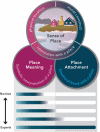Measuring novice-expert sense of place for a far-away place: Implications for geoscience instruction
- PMID: 37883501
- PMCID: PMC10602358
- DOI: 10.1371/journal.pone.0293003
Measuring novice-expert sense of place for a far-away place: Implications for geoscience instruction
Abstract
Individuals usually develop a sense of place through lived experiences or travel. Here we introduce new and innovative tools to measure sense of place for remote, far-away locations, such as Greenland. We apply this methodology within place-based education to study whether we can distinguish a sense of place between those who have visited Greenland or are otherwise strongly connected to the place from those who never visited. Place-based education research indicates that an increased sense of place has a positive effect on learning outcomes. Thus, we hypothesize that vicarious experiences with a place result in a measurably stronger sense of place when compared to the sense of place of those who have not experienced the place directly. We studied two distinct groups; the first are people with a strong Greenland connection (experts, n = 93). The second are students who have never been there (novices, n = 142). Using i) emotional value attribution of words, ii) thematic analysis of phrases and iii) categorization of words, we show significant differences between novice's and expert's use of words and phrases to describe Greenland as a proxy of sense of place. Emotional value of words revealed statistically significant differences between experts and novices such as word power (dominance), feeling pleasantness (valence), and degree of arousal evoked by the word. While both groups have an overall positive impression of Greenland, 31% of novices express a neutral view with little to no awareness of Greenland (experts 4% neutral). We found differences between experts and novices along dimensions such as natural features; cultural attributes; people of Greenland; concerns, importance, or interest in and feeling connected to Greenland. Experts exhibit more complex place attributes, frequently using emotional words, while novices present a superficial picture of Greenland. Engaging with virtual environments may shift novice learners to a more expert-like sense of place, for a far-away places like Greenland, thus, we suggest virtual field trips can supplement geoscience teaching of concepts in far-away places like Greenland and beyond.
Copyright: © 2023 Gold et al. This is an open access article distributed under the terms of the Creative Commons Attribution License, which permits unrestricted use, distribution, and reproduction in any medium, provided the original author and source are credited.
Conflict of interest statement
The authors have declared that no competing interests exist.
Figures




References
-
- Moon TA, Druckenmiller ML, Thoman RL. Arctic Report Card 2021. NOAA: Washington, DC, USA. 2021.
-
- Intergovernmental Panel on Climate Change. Climate Change. Synthesis Report. Contribution of Working Groups I, II and III to the Fifth Assessment Report of the Intergovernmental Panel on Climate Change. Pachauri RK, Meyer LA, editors. Geneva, Switzerland; 2014.
-
- Semken S, Ward EG, Moosavi S, Chinn PW. Place-based education in geoscience: Theory, research, practice, and assessment. Journal of Geoscience Education. 2017;65(4):542–62.
-
- Apple J, Lemus J, Semken S. Teaching geoscience in the context of culture and place. Journal of Geoscience Education. 2014;62(1):1–4.
Publication types
MeSH terms
LinkOut - more resources
Full Text Sources

